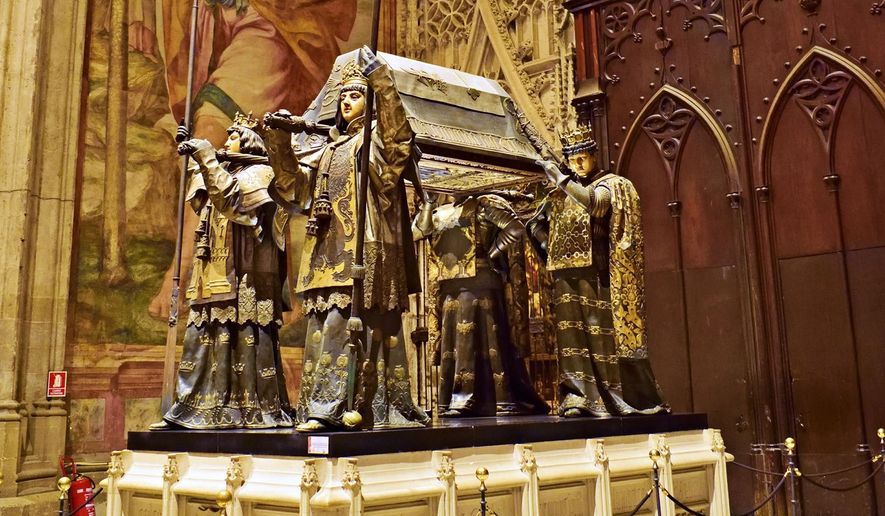OPINION:
Bursts of sunlight pierced a vivid blue Spanish sky, and I could feel my temperature rising as I walked the cobblestone streets of Seville. I had just arrived from Portugal where my fiancee and I spent a lovely day at the Palace of Pena in Sintra, and I was now cursing myself for not having known about the brutal heatwave invading the Andalusian south of Spain.
“It’s coming from Morocco,” a street vendor told me as if this revelation would somehow relieve me from the stifling 103-degree heat. Turning a corner, I stumbled across a small flock of Spanish pigeons apparently smarter than I, bird-bathing in a cool fountain as I watched them with envy.
We finally found refuge in one of the city’s greatest historical sites, the world-famous Cathedral of Seville. Rays of sunlight crept through the cathedral’s stained glass windows, but the massive stone structure sheltered us from the enemy. While walking through the cool, dark structure I saw four bronze statues of kings proudly raising a large casket above their crowns.
Intrigued, I approached and felt my heart race. I had unintentionally stumbled across the tomb of Christopher Columbus.
Paralyzed with admiration, I read about the explorer who made the most significant discovery in history. Five hundred and thirty years ago, as a young business apprentice, Columbus did what few ever do. He fulfilled a lifelong dream and changed the world. Having studied world maps in his brother’s cartography workshop in Lisbon, Columbus and his brother Bartholomew filled their days listening to sailors tell stories of their travels, inspiring the two to dream of sailing unchartered waters.
Columbus went on to commandeer ships in the Mediterranean and Atlantic, gaining the skill to achieve his ambition. When he felt confident he charted a path to Asia, he made his case to European monarchs, hoping that someone would fund his quest to the unknown.
Intrigued by his passion, Columbus was received by kings and queens in England, France, Portugal and Spain. But he was repeatedly rejected, as the monarchs’ royal councils believed the young sailor dramatically underestimated the distance to reach the East Indies.
Determined to maintain power gained during the Reconquista — wars that expanded Christianity throughout the Iberian peninsula — the Catholic monarchs of Spain, namely King Ferdinand II of Aragon and Queen Isabella I of Castille, kept Columbus loyal by funding his navigational research. For several years, Columbus did not pay for a night’s stay or a meal in their kingdoms.
Fate had reached out. Luis de Santangel, a royal clerk, convinced Isabella to commission Columbus before another monarch did.
On Aug. 3, 1492, Ferdinand and Isabella helped Columbus launch his first voyage from Palos de la Frontera off the southern coast of Spain in the Nina, Pinta and Santa Maria. He didn’t find Asia, but the once young dreamer reached the Bahamas and discovered an entire continent the Old World was unaware of.
If a picture speaks a thousand words, Columbus’ tomb speaks a million to the extent the Spanish value their history. What is the most awe-inspiring about Columbus’ resting place is not the tomb itself, but the reverence with which the Spanish designed it. The four kings carrying him are allegorical symbols of the four kingdoms of Spain that reigned during Columbus’ life — Castille, Aragon, Navara and Leon.
The message the sculpture conveys is that the Spanish hold Columbus’ ambitions for discovery in such high regard that they elevate him beyond royalty, as evidenced by the four kings literally raising him above themselves.
To date, a mystery surrounds the tomb, which was installed in Seville in 1899.
Columbus died in 1506 in Castille, but his remains were subsequently moved to the Dominican Republic, then Cuba, and then presumably back to Seville. In 1877 however, workers in the Dominican Republic’s Cathedral of Santa Maria uncovered a steel box inscribed with the words, “The illustrious and excellent man, Don Colon, Admiral of the Ocean Sea.”
Since Christopher and his brother Diego both earned the title “Admiral of the Ocean Sea,” it is unknown which tomb contains which brother. DNA tests prove both remains are indeed the brothers, and experts highly suspect those in Spain belong to Christopher. Still, in 1992, the quincentennial discovery of the Americas, the Dominicans also built a tomb in the shape of a Mayan pyramid to honor Columbus.
There are competing perspectives about the morality of what happened as a result of Columbus’ discovery. While his reaching the Americas enabled European monarchs to colonize and exploit indigenous peoples, it also led to the development of the New World, advancing civilization for humankind.
Both of these perspectives are historically factual and neither should be disregarded or forgotten.
Before leaving, my hand instinctively reached out, and I lightly brushed the tomb to make contact with the man who changed the course of the world, and at that moment I felt I was connecting with greatness. Because the determination and passion it took for Columbus, his brothers and crew to bravely explore the unknown and advance human knowledge are worthy of independent merit from what monarchs and soldiers did after his discovery to further their wealth and power.
Such determination and passion to discover the unknown is the core of which gives us purpose and is the very essence of the human spirit.
• Jeffrey Scott Shapiro is the former director of the U.S. Office of Cuba Broadcasting. He now serves on the editorial board for The Washington Times.




Please read our comment policy before commenting.